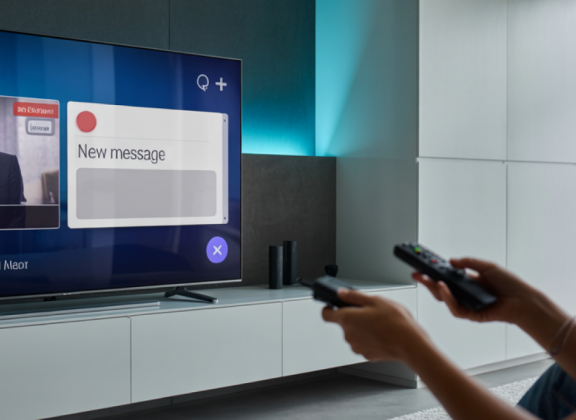In a digital ecosystem increasingly driven by user control and customization, the demand for versatile entertainment devices continues to rise. IPTV set-top boxes and media players are no longer limited to delivering content—they have evolved into multifunctional platforms capable of supporting a wide range of tasks. Among the most impactful developments in this evolution are multitasking features such as Picture-in-Picture (PiP) and parallel app operation. These tools empower users to make the most of their screen time without being tied to a single activity, redefining how we interact with content in the comfort of our homes.
Picture-in-Picture: Layered Entertainment with Zero Compromise
Picture-in-Picture is an intuitive solution for users who want to stay engaged with more than one source of content at a time. By overlaying a miniature video window on top of the main screen, PiP allows uninterrupted viewing of live broadcasts or streaming media while navigating through other applications. Whether checking system settings, browsing for the next show, or reading online content, PiP keeps core visual engagement active.
This capability is only as strong as the device that supports it. High-performance media playerss use advanced multi-core processors and dedicated video decoding units to ensure smooth playback across both the main and secondary screens. RAM capacity also plays a pivotal role; devices with 2 GB or more can efficiently manage simultaneous processes without degrading video quality or system responsiveness.
In real use, PiP becomes more than a novelty—it becomes essential. Sports enthusiasts can monitor a live game while looking up statistics. News followers can keep headlines in view while managing smart home functions. The result is a richer, more fluid entertainment environment where users remain in control of what they see and when.
True Parallelism: The Power of Running Multiple Apps
While PiP excels in dual-video tasks, the ability to run multiple applications in tandem addresses even broader user scenarios. This includes running a streaming app side by side with a web browser, messaging platform, or productivity tool—all on the same screen. For users who expect the flexibility of a PC-like experience from their media player, this capability delivers exactly that.
Modern Android-based media players with multitasking capabilities offer tailored operating environments that support split-screen modes and floating app windows. Unlike smartphones or tablets, these devices are optimized for high-resolution, continuous media playback while handling additional interfaces. Firmware enhancements often include dedicated multitasking controls, memory optimization tools, and adaptive UI elements designed for use on large displays.
This enables scenarios like watching a documentary while reading related articles, participating in a video call while taking notes, or switching between live TV and app-based services without any interruption. The key is not simply running multiple apps—it’s doing so in a way that feels native and effortless.
Behind the Scenes: The Role of Software Integration
Robust multitasking performance is the result of careful software engineering. Media players capable of seamless multitasking leverage not just hardware strength but intelligent firmware design. Responsive graphical interfaces, dynamic memory allocation, and low-latency input recognition work together to deliver a cohesive user experience. Device manufacturers that prioritize multitasking functionality ensure their systems support global gestures, app overlay frameworks, and compatibility with third-party applications. Carefully curated app ecosystems also help ensure that each app works reliably in split-screen or PiP mode, reducing user frustration. Premium devices may even include developer tools or advanced settings that allow enthusiasts to fine-tune their experience further.
A critical part of this equation is continuous support. Frequent firmware updates allow the multitasking experience to evolve in parallel with app development and Android system changes, helping the device remain future-proof and performance-optimized.
How Multitasking Benefits Everyday Users
The most compelling case for multitasking features comes from their real-world applications. Consider how a user might play a music video while adjusting playlist settings or stream educational content while simultaneously accessing a web-based resource. These seemingly small efficiencies create a significant quality-of-life improvement for the user.
In family settings, the ability to run a children’s streaming app alongside a smart home dashboard adds convenience. For those working from home, media devices that support multiple active apps can function as auxiliary productivity stations—whether it’s participating in video meetings, screen sharing, or note-taking during webinars. The flexibility extends to entertainment, learning, and even daily routines, bridging the gap between content consumption and interaction.
Choosing the Right Media Player for a Multitasking Lifestyle
To fully leverage multitasking features, device selection matters. A well-chosen IPTV box or media player will include at least a quad-core CPU, 2 GB or more of RAM, and an operating system based on Android 10 or higher. Equally crucial is support for GPU acceleration, which enhances transitions, window rendering, and visual stability during multitasking.
Also worth considering is the vendor’s track record with firmware support. Devices that receive regular updates are more likely to offer stable long-term performance, stay compatible with evolving apps, and deliver enhanced multitasking features over time. Brands that foster active user communities or developer programs tend to produce better firmware with broader customization options and more responsive support channels.
Multitasking is no longer a luxury—it’s a standard that defines how media devices are used in the modern digital household. Picture-in-Picture and dual-app capabilities significantly increase the value and usability of IPTV set-top boxes and media players. These features unlock new possibilities for how users consume, manage, and interact with content, making the entertainment experience more immersive, efficient, and personalized.
Choosing a device that excels in multitasking functionality ensures that it can serve not only as a content hub but as a flexible tool for everyday digital life. As user expectations grow, the ability to do more—without switching, pausing, or compromising—has become a cornerstone of great media technology.
